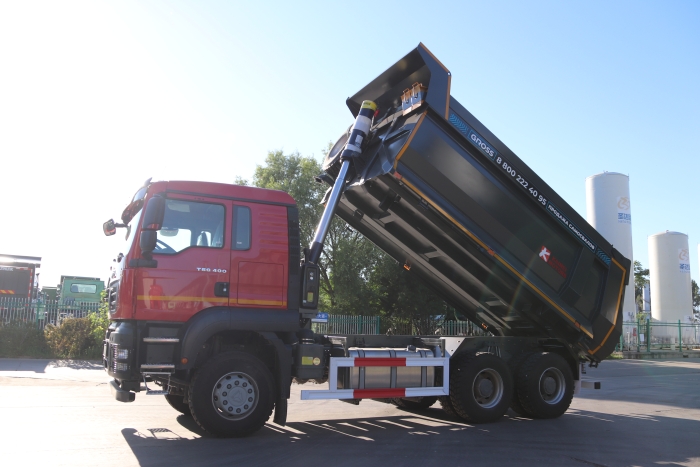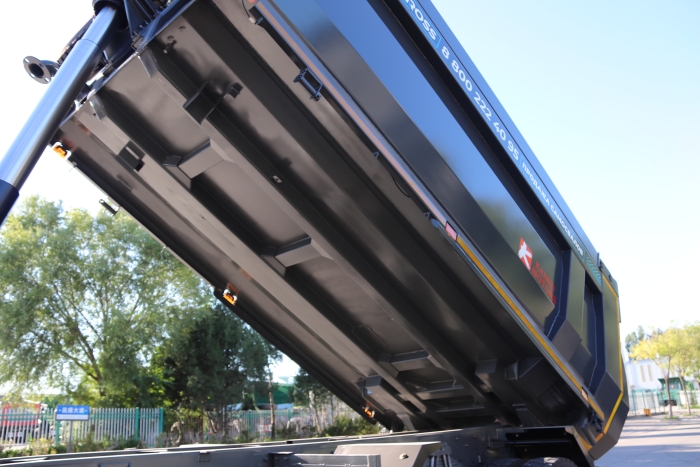- PRODUCTS
- SOLUTION
- SERVICE
- NEWS
- ABOUT US
To operate a heavy-duty rear flip semi-trailer, first ensure that the hydraulic lift system is fully functional and secure. Regularly check and maintain the hinge points and locking mechanisms for safety.
Maximum safety, as well as operational efficiency, can be easily ensured when working with a heavy-duty tipper semi-trailer when every operation is finished only after the extended preparatory phase. Therefore, between the usages, it is required to ensure that its every important part is carefully examined and prepared for the future operations.
First of all, it is important to control the workability and the condition of this system, as it is directly tasked to ensure the lifting operation. All the connections must be initially secured, and their leaking is unacceptable: the hydraulic fluid should take 75-85% of the whole reserve, which is checked by the dipstick.
The condition of the tipping mechanism should also be examined: the tipping body should not show any serious signs of wear and damage on the significant links, such as all the pins and bushings that must also be both presented and properly lubricated. Then, the operator should determine how safe is the work of the tipping body – how stable it is in the upper and lower positions.
Casings of every tire should be previously examined for any signs of the unacceptable condition – when used on a heavy-duty tipper trailer, they must be inflated to an adequate level, usually, not less than 100 and not more than 120 psi, as they are directly responsible for the safety of any vehicle. Cuts and bulges on the tires must not be ignored, as they are the direct harbingers of the accidents that may happen any time during the operations.
Finally, it is also required to check the brakes and the other elements of the whole braking system, such as brake pads and air lines, for their workability. If the static brake test shows that the trailer stays immovable when loaded and the brakes cause no delay, than the preparatory phase is completely finished. All the lights must also be checked for their operability, including standard, brake, indicator, and reversing lights, and the electrical signals.

Starting and driving a heavy-duty tipper semi-trailer is a process that needs to be executed with precision and adherence to established procedures, given the specifics of the vehicle type. Such equipment involves a specific process that the operators should follow, and instruction sequence should be employed for the initiation and driving process. Specific steps that should be followed by the operators are described further.
Before ignition, place the vehicle in neutral position, and make sure that the parking brake is engaged.
Start the engine and let it warm up by idling for several minutes. This is essential in cold weather to ensure that the oil circulates properly. Ignoring this step can damage the oil pump and may lead to complete engine failure.
Once the engine is running in idle, make sure that the operational controls are functional. Check the brake and clutch pedals for their response, and examine the steering, making sure that there is no stiffness or looseness in the system. Check all monitor gauges’ performance.
Make sure that all gauges are running in the latter’s tracks and show appropriate values.
Once the process of warm-up is finished, drive off slowly, having shifted to engagement. Take into consideration the specifics of the medium, but usually, for this type of equipment, it is advised to start in the lower gear and gradually increase gear leaving the freight physical protection, seeing the increase in speed.
The shifts of load are extremely dangerous during the process of driving, applying breaks or accelerating may result in loading loss.
To be prepared for the dangers of the transition, employ the constant speed with soft steering, ensuring that no loading shifts appear.
When moving downhill, use retarders or engine breaks to restrain the speed of the truck and avoid overheating problems of the standard slows, therefore, ensuring the lifespan of breaks is conserved.
To safely turn back and unload a heavy-duty tipper semi-trailer using hydraulic facilities, one should follow the steps listed below. However, unloading the tipper semi-trailer should be executed according to a plan to avoid tipping the trailer or losing the material.
A proper area for unloading should be level and solid. When the trailer is lifted, it should not fall or break. That is why it is important to choose the unloading area without any overhead obstacles in order to prevent the trailer from tipping over any wires, branches, or roof and underground tunnels. Also, it is crucial to choose a level space because the hydraulic pump will raise the platform so high that the trailer can be overturned on a too sloped ground.
The wheels of the trailer should be aligned with the unloading area. The vehicle should stand vertically to the area that is going to be loaded to distribute the weight. The driver should press the parking brake and make sure that the vehicle will not move. The next step is to turn the hydraulic system on to be able to lift the semi-trailer.
Start lifting the back of the trailer slowly. As the trailer raises, watch how the load on the semi-trailer reacts. If it begins to shift place or tries to come off, immediately stop raising. The truck may tip or the material in the trailer to fall. The best control method includes raising the load up until the movement of the load will start.

The next step is to watch the load as the trailer horizontal tilts. If the load does not shift, start sliding when the trailer tilts at an angle of 45 degrees. The driver should stop and manage it. The material from the body can be heavily pushed by something heavy, other materials – in this case, hit it with a crowbar.
Once the material is discharged, the trailer should be set down slowly. It is important to check if the hydraulic system is fully functional as the semi-trailer should lower down safely and return to a horizontal position.
To ensure that using a heavy-duty tipper semi-trailer is safe, it is vital to adhere to a number of crucial safety practices. Moreover, each of the stated steps has to be taken and implemented to miscellaneous safety risks to the lowest level and to operate in accordance with the necessary protective standards.
One has to arrange for regular maintenance checks, which are supposed to include checking the hydraulic system, the brakes, maintaining the tires, and making sure that the indicators work properly. Some standards have to be followed by the check, for example, the brake linings certify to be at least 1⁄4 inch thick or even more. Besides, it is necessary to inspect the tires for 2/32 inch tread depth. Make sure that every element is following the standards and not lagging behind the safely regulations.
Not only the general tipper-semi training should be done, but all the operators have to take training courses on each particular model they are going to operate. It is possible to implement these aspects into the training, such as the special emergency stop procedures, loading and unloading, as well as responding and driving operations during which operators have to master the control and the manoeuvring.
One has to follow the information provided by the constrictor about the load, which is permitted to stand in operation with the tippers. In spite of the fact that these devices are large and heavy, for example, even without any distribution the weight will be 41000 kilograms, it is possible to meet this parameter, otherwise it will be impossible to control and tip-over accidents will be more and more frequent.
When operating heavy-duty tipper semi-trailers, it is important to have effective troubleshooting steps to address emergency situations and operations. The following steps are focused on addressing some critical problems that might happen during the operation and provide quick and safe actions to respond to them.
If the hydraulic system fails and the trailer is up, make sure that the area is cleared from personnel and obstacles. Check the fluid level in the hydraulic system and add the recommended type and amount of fluid. If the problem persists, use the manual override to lower the trailer carefully.
If the brake system is not working, apply engine brake and vehicle retarder to stop the trailer in a safe way and make sure that there are no air leaks from the pneumatic lines and the connections are tight. If the brakes are not working, call for a roadside assistance service and do not move the trailer.
In case the electrical equipment and lights do not work properly, take up the fuse box and replace all the blown fuses and ensure that all connections are tight and not corroded. If the problems persist, have the electrical work done and the equipment checked by specialists.
Tire burst is one of the most dangerous emergency situations. If it happens, try to maintain control over the vehicle and slowly decrease the speed of travel without sharp braking. Replace the tire after the stoppage and ensure that the pressure and condition of the tires are checked before the trip each time.
In case of a load shift or a spill, safely stop the vehicle and put the parking brake up to prevent uncontrolled moving. Place a warning sign near the spill if it has hazard and look at the spill to determine if you can do anything to redistribute the spilled materials or call for professional support.